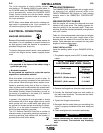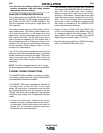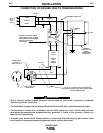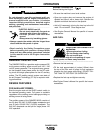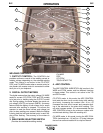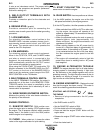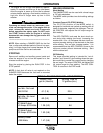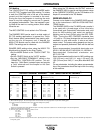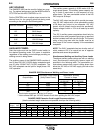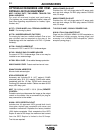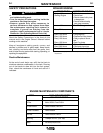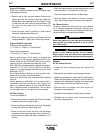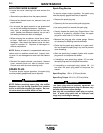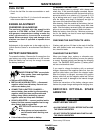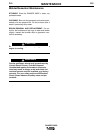
B-5
OPERATION
B-5
TIG Welding
The TOUCH START TIG setting of the MODE switch
is for DC TIG (Tungsten Inert Gas) welding. To initiate
a weld, the CONTROL dial is first set to the desired
current and the tungsten is touched to the work.
During the time the tungsten is touching the work
there is very little voltage or current and, in general,
no tungsten contamination. Then, the tungsten is gen-
tly lifted off the work in a rocking motion, which estab-
lishes the arc.
The ARC CONTROL is not active in the TIG mode.
The RANGER 305G can be used in a wide variety of
DC TIG welding applications. In general the ‘Touch
Start’ feature allows contamination free starting with-
out the use of a Hi-frequency unit. If desired, the
K930-2 TIG Module can be used with the RANGER
305G. The settings are for reference.
RANGER 305G settings when using the K930-2 TIG
Module with an Amptrol or Arc Start Switch:
• Set the MODE Switch to the TOUCH START TIG
setting.
• Set the "IDLER" Switch to the "AUTO" position.
• Set the "WELDING TERMINALS" switch to the
"REMOTELY CONTROLLED" position. This will
keep the "Solid State" contactor open and provide
a "cold" electrode until the Amptrol or Arc Start
Switch is pressed.
When using the TIG Module, the OUTPUT control on
the RANGER 305G is used to set the maximum range
of the CURRENT CONTROL on the TIG Module or an
Amptrol if connected to the TIG Module.
WIRE WELDING-CV
Connect a wire feeder to the RANGER 305G accord-
ing to the instructions in INSTALLATION INSTRUC-
TIONS Section.
The RANGER 305G in the CV-WIRE mode, permits it
to be used with a broad range of flux cored wire
(Innershield and Outershield) electrodes and solid
wires for MIG welding (gas metal arc welding).
Welding can be finely tuned using the ARC CON-
TROL. Turning the ARC CONTROL clockwise from
–10 (soft) to +10 (crisp) changes the arc from soft and
washed-in to crisp and narrow. It acts as an induc-
tance control. The proper setting depends on the pro-
cedure and operator preference. Start with the dial set
at 0.
Some recommended Innershield electrodes are:
NR-311, NS-3M, NR-207, NR-203 Ni 1%, NR-204-H.
Recommended Outershield electrodes are:
0S-70, 0S-71M.
Some recommended solid wires for MIG welding are:
.035 (0.9 mm), and .045 (1.1 mm), L-50 and L-56,
.035 (0.9 mm) and .045 (1.1 mm) Blue Max MIG 308
LS.
For any electrodes, including the above recommenda-
tions, the procedures should be kept within the rating
of the machine.
RANGER 305G
TYPICAL CURRENT RANGES
(1)
FOR TUNGSTEN ELECTRODES
(2)
Tungsten Electrode DCEN (-) DCEP (+) Approximate Argon Gas Flow TIG TORCH
Diameter in. (mm) Flow Rate C.F.H. ( l /min.) Nozzle Size (4), (5)
1%, 2% Thoriated 1%, 2% Thoriated Aluminum Stainless Steel
Tungsten Tungsten
.010 (.25) 2-15 (3) 3-8 (2-4) 3-8 (2-4) #4, #5, #6
0.020 (.50) 5-20 (3) 5-10 (3-5) 5-10 (3-5)
0.040 (1.0) 15-80 (3) 5-10 (3-5) 5-10 (3-5)
1/16 (1.6) 70-150 10-20 1 5-10 (3-5) 9-13 (4-6) #5, #6
3/32 (2.4) 150-250 15-30 1 13-17 (6-8) 11-15 (5-7) #6, #7, #8
1/8 (3.2) 250-400 25-40 15-23 (7-11) 11-15 (5-7)
5/32 (4.0) 400-500 40-55 21-25 (10-12) 13-17 (6-8) #8, #10
3/16 (4.8) 500-750 55-80 23-27 (11-13) 18-22 (8-10)
1/4 (6.4) 750-1000 80-125 28-32 (13-15) 23-27 (11-13)
(1) When used with argon gas. The current ranges shown must be reduced when using argon/helium or pure helium shielding gases.
(2) Tungsten electrodes are classified as follows by the American Welding Society (AWS):
Pure EWP
1% Thoriated EWTh-1
2% Thoriated EWTh-2
Though not yet recognized by the AWS, Ceriated Tungsten is now widely accepted as a substitute for 2% Thoriated Tungsten in AC and DC applications.
(3) DCEP is not commonly used in these sizes.
(4) TIG torch nozzle "sizes" are in multiples of 1/16ths of an inch:
# 4 = 1/4 in. (6 mm)
# 5 = 5/16 in. (8 mm)
# 6 = 3/8 in. (10 mm)
# 7 = 7/16 in. (11 mm)
# 8 = _ in. (12.5 mm)
#10 = 5/8 in. (16 mm)
(5) TIG torch nozzles are typically made from alumina ceramic. Special applications may require lava nozzles, which are less prone to breakage, but cannot withstand high temperatures
and high duty cycles.



